
Wine Culture and Information since 2002 - Volume 22
 Wine Culture and Information since 2002 - Volume 22 |
|
Issue 147, January 2016 |
Contents |
|
|
Milan Pays a Tribute to Luigi Veronelli |
|
I am very glad to see Milan, after eleven years he passed away, finally pays a tribute to Luigi Veronelli, one of its most famous sons, fundamental figure in the history and communication of Italian wine and food. To tell the truth, the tribute of Milan to Luigi Veronelli has begun on January 2015, by dedicating to him an interesting exhibition with the evoking title “Camminare la Terra” (Walking the Land) at the “Triennale” building. The exhibition has therefore moved to Bergam in the Monastery of Astino and ended on 31 October 2015, the same day in which Expo 2015 ended too. After eleven years, Milan finally dedicates a street of the city to Luigi Veronelli, the city where he was born in 1926. This street, a “promenade” to be precise, is in the Isola district where the Veronelli family had a house in Carlo Archinto square and where the great Gino spent his youth. On this regard, Isola district of Milan certainly is the best way to pay a tribute to Luigi Veronelli. The decision has been announced on September 2015, however the official inauguration of “Passeggiata Luigi Veronelli” has been celebrated on 30 November 2015. The promenade is found in the new urban complex called “progetto Porta Nuova”, built in the Isola district and culminating in Gae Aulenti square, near the Pelli tower and the residential center called “Bosco Verticale”. Passeggiata Luigi Veronelli in fact joins Gaetano De Castilla street to Gae Aulenti square, not so far from Carlo Archinto square, where the great Gino was born in February 2nd, 1926. Today this area has of course changed since the times of Luigi Veronelli: something normal as things change and evolve according to needs and time. From Gaetano De Castilla street, the promenade offers a beautiful sight to the complex built in Gae Aulenti square, whereas from the opposite side it is possible to see “Bosco Verticale”.
As far as I know, Milan is the seventh municipality in Italy to dedicate a street or square to Luigi Veronelli and I wish it will not be the last. The other municipalities of Italy to dedicate streets or squares to Luigi Veronelli are Bergam, Fivizzano (Massa Carrara), Vigolzone (Piacenza), Zola Predosa (Bologna), Castelvetrano (Trapani) and Menfi (Agrigento). Fundamental figure for the communication of wine and food in Italy, it is undeniable the huge job done by Luigi Veronelli has strongly influenced the recent history and development of wine, grapes, food and olive oil in Italy. I in fact believe no one can deny this: without the contribution of Luigi Veronelli, today the world of enogastronomic communication in Italy would not be the same and would not get so much attention. I am also convinced without the effort and commitment of Luigi Veronelli - he began writing about wine and food in the 1950s - today many writers would simply do something else. I am also aware this is particularly true for myself - although I am absolutely aware to be so far away from his greatness and style - as I admit I owe very much to the reports and books written by Luigi Veronelli. My very first readings about wine were in fact written by the great Gino, charmed by his inimitable style in telling wines and food, a style sometimes badly and awkwardly copied by presumptuous pens or keyboards with ridiculous and piteous results. Luigi Veronelli's style belonged to him only, fruit of his culture and knowledge, great artist in creating neologisms of great effect, still today alive and significant. I like to mention, among the many expressions created by Luigi Veronelli for wine and still today alive, vino da meditazione (meditation wine), vino da favola (fabled wine) and vino di zerga beva (a wine with personality inviting to enjoy it more and more), to which are added the terms nerbo (vigorous wine), stoffa (texture) and the list would be long and amazing. Luigi Veronelli has been the first one to describe wines and food in a very personal way, a very personal style and belonged to him only, genuine and credible only in case it was created by the pen of Veronelli.
Also unforgettable, the TV shows in which he took part, such as the well known “A tavola alle sette”, with the Italian actress Ave Ninchi and, before her, Delia Scala and Umberto Orsini, including the extraordinary “Viaggio Sentimentale nell'Italia dei Vini” (sentimental journey to the Italy of wines). This latter TV shows has been a fundamental moment for Italian wine - it was 1979 - a report, sometimes provocative, about the condition of wineries and vintners of that time. Not to mention the huge production of books, reports and articles Luigi Veronelli has written in the course of his career and, it should be said, not only about wine. Luigi Veronelli was also involved in writing about gastronomy and olive oil, as well as philosophy and politics. On this regard, it should be noticed Luigi Veronelli was graduated in philosophy and he also had the chance to attend some lessons of Benedetto Croce in Milan, something which influenced his political views. Milan, the city where he was born, ends the year dedicated to Luigi Veronelli with many events, also by dedicating to him a street in his Isola district. A right tribute finally paid to this great figure of the 1900s, someone who played a fundamental role in reevaluating and revolutionizing the culture of wine and food in Italy. A way to let Milanese people keep a memory about one of the greatest sons of their city, by walking a street which is quite busy already and leading to Gae Aulenti square, an important meeting place of Milan. I wish Milanese people, by walking this street, to take a look to the plates at the sides of this promenade, in order to remember about Luigi Veronelli, journalist and writer. A wish also to all Milanese youngsters - who are used to speed this promenade with their skate boards, rollers and bicycles - in the hope they will at least ask themselves who was the man to whom this street was dedicated to. Because it is youngsters turn, today, to benefit from the teachings of Luigi Veronelli and to perpetuate his job, a giant of enogastronomy and a free man, in his life, thoughts and ideas. Antonello Biancalana
|
||||||||||||||||||||
Contrasts of Friulano and Malvasia IstrianaTwo of the most famous white berried grapes of Friuli Venezia Giulia compared in our glasses. Different varieties, even distant ones, however expression of their land |
|
This month we are going to pour in our glasses two white wines from Friuli Venezia Giulia and produced with two of the most well known white berried grapes of this land. This Northern-Eastern region of Italy offers a view of grapes and lands pretty singular, certainly among the most famous wine lands of Italy and successful in the world. In particular famous for its white wines, Friuli Venezia Giulia, besides having in its vineyards international varieties, offers a remarkable selection of wines produced with genuine indigenous grapes. The bond of Friuli Venezia Giulia to white grapes is strong and historical, despite today are red grapes cultivated in this region to be successful in Italy and abroad. White wines of Friuli Venezia Giulia, and therefore its indigenous and international grapes, play in fact a fundamental role in the wine making scene of Italy. There are many grapes cultivated in this region and all having an extraordinary enological value, with a production virtually embracing every wine style, from dry whites to sweet wines made from dried grapes. Among the white berried grapes, there is one to be particularly notable, that is the grape now called Friulano, because of the recent happenings which forced the grape to change its name after having been called Tocai Friulano for a very long time. It is the only glory of Friuli Venezia Giulia, as there are many grapes which made this region famous, such as the whites Ribolla Gialla, Verduzzo, Malvasia Istriana and Picolit, the reds Refosco dal Peduncolo Rosso, Schioppettino, Pignolo and Tazzelenghe. In the region are also found international varieties, widely introduced to this territory, as well as all over the Northern-Eastern part of Italy, after the unlucky effects of phylloxera. The spreading of international grapes is still today important and they are in fact widely found in many Denominazione d'Origine Controllata wines of this region. Friulano received quite a lot of attention in recent times because of the long controversy it had with the Hungarian wine Tokaji, at the end of which was decided the change of its name. Because of this decision, as of March 2007, the glorious Tocai Friulano - frequently called in short as “Tocai” - had to change its name into Friulano, after having pondered the possibility of calling it Tai. Friuli Venezia Giulia tried, with no success, to oppose to this decision, however as of vintage 2008 in the labels of bottles the mention Tocai Friulano has been replaced with Friulano. Of course, the glory and greatness of the grape did not change despite it had to change its name. It should however be noticed none of the grapes used for the production of Hungarian wine Tokaji - the most famous of them is Furmint - has a connection to Friulano as they are absolutely different varieties. Wines produced with Friulano gives to the sense of the taster typical qualities capable of giving them a remarkable personality. Bitter almond certainly is among the main olfactory sensations which can be perceived from a glass of Friulano, a quality that - it should be said - shares with other grapes as well. Wines produced with Friulano can be appreciated for a pleasing and slightly bitter taste perceived after having swallowed the wine. Most of the wines produced with this grape are dry, however there also are examples of sweet wines. Friulano is particularly found in Friuli Venezia Giulia, its homeland. It should also be noticed this grape is found, although marginally, in Veneto - it is found in Bianco di Custoza wines - and in Lombardy is used for the wines of San Martino della Battaglia. Friulano is generally vinified in inert containers - in order to keep its characteristic aromas of bitter almond - and sometimes it is fermented and aged in cask as well. The history of Malvasia Istriana is different, better to say, of Malvasia grapes as with this name are generally identified a pretty vast family of grapes. It is a very ancient varieties which have always been successful, catching the attention of men since the dawn of wine history and of which are found many mentions in documents of the past. The name Malvasia comes from the Greek city of Monemvasia, in the Peloponnese, where the famous wines produced in this area were shipped all over Europe. The name Monemvasia has been changed in the course of time and became Malvasia, a term used for calling the wines recalling the original wine making style of this Greek city. The spreading of Malvasia grapes is vast, and only in Italy can be counted many varieties having this name, both white and red berried grapes.
Grapes belonging to the family of Malvasia are considered, in general terms, semi-aromatic varieties, that is capable of making wines with sensorial qualities recalling grape juice, although not dominant. This characteristic is found in wines produced with the varieties called Malvasia, however this is not true for Malvasia Istriana, as it represents an exception to this quality. If it is true in wines produced with Malvasia can be perceived the aroma of grape, the same found in Muscat blanc, this is a quality missing in Malvasia Istriana. Of the Malvasia grapes, the Istriana has the quality of making wines with a moderate body yet elegant, in particular those made from grapes cultivated in plain lands. Malvasia Istriana is particularly found in Collio and Carso areas - here are being produced the best expressions of the region - and it is also cultivated in the neighboring Slovenia and Croatia where it is known as Malvazija Istarska. Just like Friulano, Malvasia Istriana is mainly vinified in inert containers and the production in cask is not so common. Our tasting by contrast will examine a Colli Orientali del Friuli Friulano and a Collio Malvasia. It should be noticed that, in general terms, in bottles of Malvasia is rarely written the term “Istriana”, a characteristic which must be considered implicit, as it is exclusively made with Malvasia Istriana. In choosing our wines we will pick two bottles vinified in inert containers, possibly in steel tanks, in order to better appreciate the specific qualities of the grapes. Getting two wines with these characteristics should not be difficult as the vinification in inert containers is what it is mainly adopted for both varieties. The two wines must belong to the most recent vintage, therefore we will focus on the comparison of young wines. Our Colli Orientali del Friuli Friulano and Collio Malvasia will be served in tasting glasses at a temperature of 10 °C (50 °F). After having poured the two wines in the glasses, let's begin our tasting by contrast from appearance analysis, that is the phase in which is being evaluated color and transparency. We will begin the examination of the appearance by evaluating the glass of Colli Orientali del Friuli Friulano. Let's tilt the glass over a white surface and observe the wine at the base. The color Friulano shows to our sight is an intense and briliant straw yellow, frequently showing a hue of greenish yellow. Nuances of Friulano, observed at the edge of the glass, show a greenish yellow color, also a proof of the young age of the wine. The color of Collio Malvasia is evidently paler than Friulano: in this case it is the greenish yellow color to be mainly seen, brilliant and intense, sometimes showing straw yellow hues. Nuances of Malvasia is not so different from what we already observed at the base of the glass, by confirming an evident greenish yellow hue. The aromas expressed by Friulano and Malvasia Istriana give to the sense of the taster olfactory profiles in which can be perceived remarkable differences. One of the dominant qualities of Friulano is expressed by a strong aroma of bitter almond, a characteristic very appreciated in wines produced with this variety. It should be said the bitter almond aroma is also perceived in other varieties, mainly white berried ones, and it is also possible to find it in red grapes. Of course, there is more than bitter almond in Friulano, an olfactory profile in which are expressed aromas of white and yellow fruits and flowers. The olfactory profile of Malvasia Istriana substantially differs from Friulano, however expressing in its wines interesting aromas of fruits and flowers. The aging in wood of wines produced with these two varieties, although this is not so common, adds tertiary aromas sometimes covering the typical qualities of the two grapes. For this reason, it is thanks to the skill of producer to keep the personality of Friulano and Malvasia Istriana by adding, at the same time, complexity to the aromas of wine. Let's start the evaluation of aromas from Colli Orientali del Friuli Friulano. By keeping the glass in vertical position and without swirling, let's proceed with the first smell in order to appreciate the opening of wine. From the glass will be perceived, strong and clean, the characteristic aroma of bitter almond, well mixed to sensations recalling white fruits. Specifically, Friulano gives opening aromas of apple, pear and bitter almond. After having swirled the glass, let's tilt it and smell: the wine will complete its olfactory profile with hawthorn, peach, broom, plum, pineapple and, sometimes, hay. Let's now pass to the opening of Collio Malvasia. The first smell will bring to our senses aromas of apple, peach and hawthorn, very different from Friulano. It will be noticed the absence of bitter almond, as well as hints of grape juice, sometimes found in grapes belonging to the Malvasia family. After having swirled the glass, the olfactory profile of Collio Malvasia is completed by pear, plum, apricot, citrus fruits, as well as sensations of tropical fruits such as pineapple and banana. The tasting of the two wines reveals substantial differences, not only in the taste but also in tactile sensations, structure in particular. The attack of Colli Orientali del Friuli Friulano is characterized by a pleasing crispness and structure. In the mouth can be perceived the good correspondence to the nose, in particular bitter almond, apple, plum and peach. The attack of Collio Malvasia too has a pleasing crispness but, as opposed to Friulano, the perception of structure is evidently lighter, however having a remarkable agreeableness. Correspondence to the nose is very good and it will be possible to perceive clean flavors of apple, peach and pear, sometimes pineapple. In both cases it is evident the role played by alcohol - it can easily be as high as 13% - giving balance to the crispness of both wines and making them particularly dry. The final part of our tasting by contrast continues to reveal substantial differences between Friulano and Malvasia Istriana. The finish of Colli Orientali del Friuli Friulano is still characterized by the flavor of bitter almond, also giving the wine its typical slightly bitter aftertaste, a pleasing quality in case it is not excessively intense. Persistence is generally very good, leaving in the mouth, besides the aforementioned bitter almond, flavors of apple, plum, peach and pear. A different finish is given by Collio Malvasia in which can be appreciated its pleasing crispness, with a good persistence characterized by the flavors of peach, apple, plum and pineapple. The sensation of structure is different in both wines: the finish of Friulano leaves to the mouth a more robust sensation of body than Malvasia Istriana. They however are agreeable and immediate wines, most of the times produced in order to favor the very good agreeableness the two varieties from Friuli Venezia Giulia can give to their wines.
|
||||||||||||
Wines of the Month |
|
|
|
Score legend Prices are to be considered as indicative. Prices may vary according to the country or the shop where wines are bought |

|
|
Spoleto Trebbiano Spoletino Trebium 2014 |
|
| Antonelli San Marco (Umbria, Italy) | |
 Trebbiano Spoletino Trebbiano Spoletino | |
| Price: € 11.90 | Score: |
 Intense straw yellow and nuances of golden yellow, very transparent. Intense straw yellow and nuances of golden yellow, very transparent. Intense, clean, pleasing, refined and elegant, starts with hints of
medlar, apple and pear followed by aromas of peach, lychee, plum, hawthorn,
pineapple, broom, honey, mineral and hints of vanilla. Intense, clean, pleasing, refined and elegant, starts with hints of
medlar, apple and pear followed by aromas of peach, lychee, plum, hawthorn,
pineapple, broom, honey, mineral and hints of vanilla.
 Crisp attack and however balanced by alcohol, good body, intense
flavors, agreeable. Crisp attack and however balanced by alcohol, good body, intense
flavors, agreeable.
 Persistent finish with flavors of apple, medlar and plum. Persistent finish with flavors of apple, medlar and plum. 6 months in cask, 4 months in bottle. 6 months in cask, 4 months in bottle. |
|
 Cold cuts, Pasta with meat, Roasted fish, Sauteed white meat Cold cuts, Pasta with meat, Roasted fish, Sauteed white meat |
|

|
|
Montefalco Sagrantino 2010 |
|
| Antonelli San Marco (Umbria, Italy) | |
 Sagrantino Sagrantino | |
| Price: € 27.50 | Score: |
 Intense ruby red and nuances of garnet red, little transparency. Intense ruby red and nuances of garnet red, little transparency. Intense, clean, pleasing, refined and elegant, starts with hints of
blackberry, black cherry and plum followed by aromas of dried violet,
blueberry, tobacco, chocolate, leather, vanilla, cinnamon, mace, pink
pepper and menthol. Intense, clean, pleasing, refined and elegant, starts with hints of
blackberry, black cherry and plum followed by aromas of dried violet,
blueberry, tobacco, chocolate, leather, vanilla, cinnamon, mace, pink
pepper and menthol.
 Tannic attack and however balanced by alcohol, full body, intense
flavors, pleasing roundness. Tannic attack and however balanced by alcohol, full body, intense
flavors, pleasing roundness.
 Persistent finish with flavors of blackberry, black cherry and plum. Persistent finish with flavors of blackberry, black cherry and plum. 24 months in cask, 12 months in bottle. 24 months in cask, 12 months in bottle. |
|
 Game, Roasted meat, Stewed and braised meat, Hard cheese Game, Roasted meat, Stewed and braised meat, Hard cheese |
|
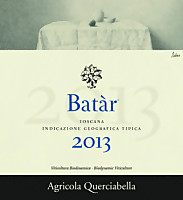
|
|
Batàr 2013 |
|
| Querciabella (Tuscany, Italy) | |
 Chardonnay (50%), Pinot Bianco (50%) Chardonnay (50%), Pinot Bianco (50%) | |
| Price: € 65.00 | Score: |
 Brilliant straw yellow and nuances of straw yellow, very transparent. Brilliant straw yellow and nuances of straw yellow, very transparent. Intense, clean, pleasing, refined and elegant, starts with hints of
banana, apple and plum followed by aromas of acacia, pear, grapefruit,
butter, mango, bergamot, vanilla, hawthorn, honey and mineral. Intense, clean, pleasing, refined and elegant, starts with hints of
banana, apple and plum followed by aromas of acacia, pear, grapefruit,
butter, mango, bergamot, vanilla, hawthorn, honey and mineral.
 Crisp attack and however balanced by alcohol, full body, intense
flavors, pleasing roundness. Crisp attack and however balanced by alcohol, full body, intense
flavors, pleasing roundness.
 Very persistent finish with long flavors of apple, banana and plum. Very persistent finish with long flavors of apple, banana and plum. Fermented in barrique, about 12 months of aging in barrique. Fermented in barrique, about 12 months of aging in barrique. |
|
 Roasted fish, Stuffed pasta with mushrooms, Roasted white meat, Stewed white meat Roasted fish, Stuffed pasta with mushrooms, Roasted white meat, Stewed white meat |
|
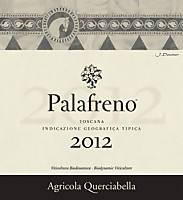
|
|
Palafreno 2012 |
|
| Querciabella (Tuscany, Italy) | |
 Merlot Merlot | |
| Price: € 140.00 | Score: |
 Intense ruby red and nuances of ruby red, little transparency. Intense ruby red and nuances of ruby red, little transparency. Intense, clean, pleasing, refined and elegant, starts with hints of
black currant, plum and black cherry followed by aromas of blueberry,
violet, peony, chocolate, tobacco, vanilla, leather, pink pepper, mace and
eucalyptus. Intense, clean, pleasing, refined and elegant, starts with hints of
black currant, plum and black cherry followed by aromas of blueberry,
violet, peony, chocolate, tobacco, vanilla, leather, pink pepper, mace and
eucalyptus.
 Tannic attack and however balanced by alcohol, full body, intense
flavors, pleasing roundness, Tannic attack and however balanced by alcohol, full body, intense
flavors, pleasing roundness,
 Very persistent finish with flavors of black currant, black cherry and
blueberry. Very persistent finish with flavors of black currant, black cherry and
blueberry.
 18 months in barrique, 6 months in bottle. 18 months in barrique, 6 months in bottle. |
|
 Game, Stewed and braised meat, Roasted meat, Hard cheese Game, Stewed and braised meat, Roasted meat, Hard cheese |
|
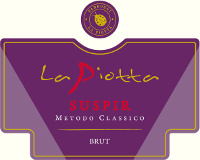
|
|
Oltrepo Pavese Metodo Classico Cruasé Pinot Nero Brut Rosé Suspir 2011 |
|
| La Piotta (Lombardy, Italy) | |
 Pinot Nero Pinot Nero | |
| Price: € 13.00 | Score: |
 Intense cherry pink and nuances of cherry pink, moderate transparency,
fine and persistent perlage. Intense cherry pink and nuances of cherry pink, moderate transparency,
fine and persistent perlage.
 Intense, clean, pleasing and refined, starts with hints of cherry,
apple and raspberry followed by aromas of blueberry, plum, yeast,
strawberry and cyclamen. Intense, clean, pleasing and refined, starts with hints of cherry,
apple and raspberry followed by aromas of blueberry, plum, yeast,
strawberry and cyclamen.
 Effervescent and crisp attack, however balanced by alcohol, good body,
intense flavors, agreeable. Effervescent and crisp attack, however balanced by alcohol, good body,
intense flavors, agreeable.
 Persistent finish with flavors of cherry, raspberry and apple. Persistent finish with flavors of cherry, raspberry and apple. Refermented in bottle on its lees for 24 months. Refermented in bottle on its lees for 24 months. |
|
 Pasta with meat, Stewed fish, Sauteed meat, Mushroom soups Pasta with meat, Stewed fish, Sauteed meat, Mushroom soups |
|
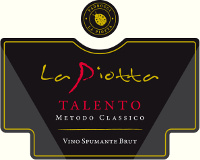
|
|
Oltrepo Pavese Metodo Classico Talento Pinot Nero Brut 2011 |
|
| La Piotta (Lombardy, Italy) | |
 Pinot Nero Pinot Nero | |
| Price: € 12.00 | Score: |
 Brilliant straw yellow and nuances of straw yellow, very transparent,
fine and persistent perlage. Brilliant straw yellow and nuances of straw yellow, very transparent,
fine and persistent perlage.
 Intense, clean, pleasing and refined, starts with hints of apple, plum
and bread crust followed by aromas of raspberry, yeast, pineapple,
hawthorn, pear and hazelnut. Intense, clean, pleasing and refined, starts with hints of apple, plum
and bread crust followed by aromas of raspberry, yeast, pineapple,
hawthorn, pear and hazelnut.
 Effervescent and crisp attack, however balanced by alcohol, good body,
intense flavors, pleasing roundness. Effervescent and crisp attack, however balanced by alcohol, good body,
intense flavors, pleasing roundness.
 Persistent finish with flavors of apple, pineapple and plum. Persistent finish with flavors of apple, pineapple and plum. Refermented in bottle on its lees for 24 months. Refermented in bottle on its lees for 24 months. |
|
 Pasta with fish, Stewed fish, Roasted white meat, Broiled crustaceans Pasta with fish, Stewed fish, Roasted white meat, Broiled crustaceans |
|
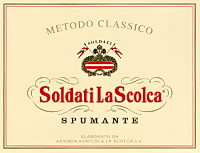
|
|
Soldati La Scolca Metodo Classico Brut |
|
| La Scolca (Piedmont, Italy) | |
 Cortese Cortese | |
| Price: € 18.00 | Score: |
 Brilliant straw yellow and nuances of straw yellow, very transparent,
fine and persistent perlage. Brilliant straw yellow and nuances of straw yellow, very transparent,
fine and persistent perlage.
 Intense, clean, pleasing and refined, starts with hints of apple, plum
and bread crust followed by aromas of peach, almond, yeast, pear, hawthorn,
broom and mineral. Intense, clean, pleasing and refined, starts with hints of apple, plum
and bread crust followed by aromas of peach, almond, yeast, pear, hawthorn,
broom and mineral.
 Effervescent and crisp attack, however balanced by alcohol, good body,
intense flavors, agreeable. Effervescent and crisp attack, however balanced by alcohol, good body,
intense flavors, agreeable.
 Persistent finish with flavors of apple, plum and peach. Persistent finish with flavors of apple, plum and peach. Refermented in bottle on its lees for more than 24 months. Refermented in bottle on its lees for more than 24 months. |
|
 Pasta with meat, Roasted meat, Roasted white meat, Stewed fish, Mushroom soups Pasta with meat, Roasted meat, Roasted white meat, Stewed fish, Mushroom soups |
|
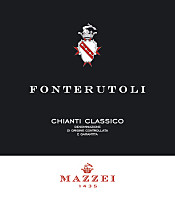
|
|
Chianti Classico Fonterutoli 2013 |
|
| Castello di Fonterutoli (Tuscany, Italy) | |
 Sangiovese (90%), Malvasia Nera, Colorino, Merlot (10%) Sangiovese (90%), Malvasia Nera, Colorino, Merlot (10%) | |
| Price: € 16.00 | Score: |
 Brilliant ruby red and nuances of ruby red, moderate transparency. Brilliant ruby red and nuances of ruby red, moderate transparency. Intense, clean, pleasing and refined, starts with hints of black
cherry, plum and violet followed by aromas of blueberry, raspberry,
blackberry, vanilla, mace and carob. Intense, clean, pleasing and refined, starts with hints of black
cherry, plum and violet followed by aromas of blueberry, raspberry,
blackberry, vanilla, mace and carob.
 Properly tannic attack and however balanced by alcohol, good body,
intense flavors, agreeable. Properly tannic attack and however balanced by alcohol, good body,
intense flavors, agreeable.
 Persistent finish with flavors of black cherry, plum and raspberry. Persistent finish with flavors of black cherry, plum and raspberry. 12 months in barrique and cask. 12 months in barrique and cask. |
|
 Broiled meat and barbecue, Roasted meat, Stewed meat with mushrooms, Hard cheese Broiled meat and barbecue, Roasted meat, Stewed meat with mushrooms, Hard cheese |
|
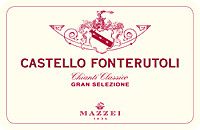
|
|
Chianti Classico Castello Fonterutoli Gran Selezione 2011 |
|
| Castello di Fonterutoli (Tuscany, Italy) | |
 Sangiovese (92%), Malvasia Nera, Colorino (8%) Sangiovese (92%), Malvasia Nera, Colorino (8%) | |
| Price: € 38.00 | Score: |
 Intense ruby red and nuances of garnet red, little transparency. Intense ruby red and nuances of garnet red, little transparency. Intense, clean, pleasing, refined and elegant, starts with hints of
black cherry, plum and violet followed by aromas of blueberry, blackberry,
cocoa, tobacco, mace, leather, menthol and vanilla. Intense, clean, pleasing, refined and elegant, starts with hints of
black cherry, plum and violet followed by aromas of blueberry, blackberry,
cocoa, tobacco, mace, leather, menthol and vanilla.
 Properly tannic attack and however balanced by alcohol, good body,
intense flavors, agreeable. Properly tannic attack and however balanced by alcohol, good body,
intense flavors, agreeable.
 Persistent finish with flavors of black cherry, plum and blackberry. Persistent finish with flavors of black cherry, plum and blackberry. 20 months in barrique and cask. 20 months in barrique and cask. |
|
 Roasted meat, Broiled meat and barbecue, Stewed and braised meat, Hard cheese Roasted meat, Broiled meat and barbecue, Stewed and braised meat, Hard cheese |
|
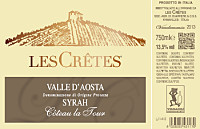
|
|
Valle d'Aosta Syrah Côteau la Tour 2013 |
|
| Les Crêtes (Vallée d'Aoste, Italy) | |
 Syrah Syrah | |
| Price: € 16.90 | Score: |
 Intense ruby red and nuances of ruby red, little transparency. Intense ruby red and nuances of ruby red, little transparency. Intense, clean, pleasing and refined, starts with hints of black
currant, black cherry and blueberry followed by aromas of plum, violet,
blackberry, raspberry, black pepper, chocolate and vanilla. Intense, clean, pleasing and refined, starts with hints of black
currant, black cherry and blueberry followed by aromas of plum, violet,
blackberry, raspberry, black pepper, chocolate and vanilla.
 Properly tannic attack and however balanced by alcohol, good body,
intense flavors, agreeable. Properly tannic attack and however balanced by alcohol, good body,
intense flavors, agreeable.
 Persistent finish with flavors of black currant, black cherry and
blueberry. Persistent finish with flavors of black currant, black cherry and
blueberry.
 12 months in cask, 6 months in bottle. 12 months in cask, 6 months in bottle. |
|
 Stewed and braised meat with mushrooms, Broiled meat and barbecue, Cheese Stewed and braised meat with mushrooms, Broiled meat and barbecue, Cheese |
|
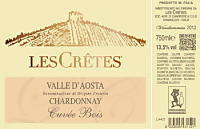
|
|
Valle d'Aosta Chardonnay Cuvée Bois 2013 |
|
| Les Crêtes (Vallée d'Aoste, Italy) | |
 Chardonnay Chardonnay | |
| Price: € 35.65 | Score: |
 Intense straw yellow and nuances of straw yellow, very transparent. Intense straw yellow and nuances of straw yellow, very transparent. Intense, clean, pleasing, refined and elegant, starts with hints of
banana, acacia and plum followed by aromas of apple, pear, butter,
hawthorn, vanilla, hazelnut, grapefruit, praline and mineral. Intense, clean, pleasing, refined and elegant, starts with hints of
banana, acacia and plum followed by aromas of apple, pear, butter,
hawthorn, vanilla, hazelnut, grapefruit, praline and mineral.
 Crisp attack and however balanced by alcohol, full body, intense
flavors, pleasing roundness. Crisp attack and however balanced by alcohol, full body, intense
flavors, pleasing roundness.
 Very persistent finish with long flavors of apple, banana and plum. Very persistent finish with long flavors of apple, banana and plum. Fermented in cask, 10 months of aging in cask, 8 months of aging in
bottle. Fermented in cask, 10 months of aging in cask, 8 months of aging in
bottle.
|
|
 Pasta with meat, Roasted white meat, Roasted fish, Cheese Pasta with meat, Roasted white meat, Roasted fish, Cheese |
|
News |
|
In this section are published news and information about events concerning the world of wine and food. Whoever is interested in publishing this kind of information can send us a mail to our address.
|
AquavitaeReview of Grappa, Distillates and Brandy |
|
|
||||||||||||||
Wine Guide ParadeOctober 2015
|
| |||||||
Privacy Policy | |||||||


| Copyright © 2002-2024 Antonello Biancalana, DiWineTaste - All rights reserved |
| All rights reserved under international copyright conventions. No part of this publication and of this WEB site may be
reproduced or utilized in any form or by any means, electronic or mechanical, without permission in writing from DiWineTaste. |